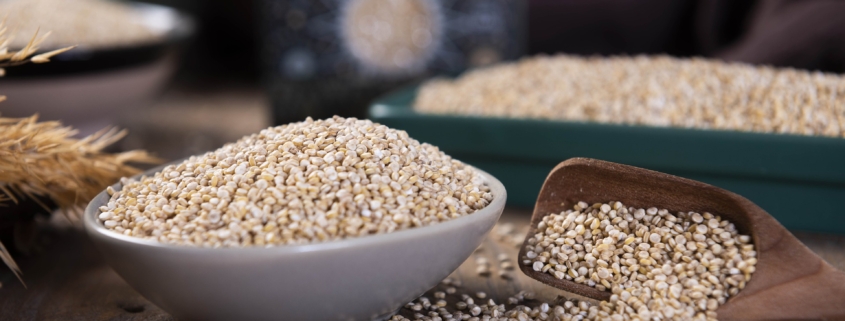Keen on Quinoa
Background
The demand for quinoa has risen sharply in recent years. It is a fantastic wheat-free, complete protein that is full of nutritional benefits. Today we’ll look at ways to enjoy this uber-trendy ancient grain.
Quinoa (pronounced ‘keen-wa’) is a great wheat-free alternative to starchy grains. It is a very small, round grain that comes in two basic varieties: red quinoa and creamy white. Both types have a somewhat nutty, slightly bitter taste when cooked. They open up to release little white curls (like a tail) as they soften. Even though it is counted as a grain, it is a member of the beet, chard, and spinach family.
Quinoa is native to South America (Peru, Chile and Bolivia), and this area of the world remains the greatest exporters of the grain today. It was a staple in the diet of the ancient Incas and their descendants. Lately, foodies in the UK and the US have given a massive welcome to the grain, heralding it as a superior alternative to bulgur wheat, couscous and rice. Another reason quinoa is so popular is because it is a very low-allergenic grain, making it more likely to be well-tolerated by those with allergies, celiac disease, or other food intolerances.
Nutritional Benefits of Quinoa
- Quinoa has an excellent nutrient profile and many benefits. Quinoa has twice the protein content of rice and barley, and also has all nine essential amino acids, making it a complete protein choice. This is especially good news for those who eat little animal protein, such as vegetarians and vegans, and other individuals who have a difficult time meeting their protein requirements.
- It is a very good source of the minerals calcium, magnesium and manganese.
- Quinoa contains respectable levels of several B vitamins, which benefit the energy and cell production in the body.
- It contains vitamin E, an essential antioxidant vitamin.
- One cup contains 7 grams of fiber, which is very important for gastrointestinal health, satiety, and regularity, as well as keeping a healthy gut microbiota. Eating quinoa, along with other whole grains, is a great way to get your daily quota (between 25-35 grams per day for most healthy adults). The high fiber content, along with the high protein content, helps slow the release of carbs into the blood, making quinoa a lower glycemic-load option for those looking for better blood sugar control.
- Contains anti-inflammatory phytonutrients, which aid in the prevention and treatment of aging and disease, especially chronic ailments such as heart disease and cancer.
- Contains some omega-3 fatty acids, which are heart-healthy, monounsaturated fats that reduce inflammation and promote health.
Preparation Tips
To prepare, rinse the seeds under cold water. Once you have rinsed it well, cook as you would rice, with one part quinoa to two parts liquid. When cooked, quinoa seeds become fluffy and creamy, with a slight crunch. It has a delicate and subtle nutty flavor.
Make sure there aren’t holes in the packet of quinoa you are buying to ensure optimal freshness of the grain. Store in an airtight container and keep it in a cool, dry place where it can last for several months.
Quinoa is so versatile, you’ll want to try it many ways! Use it in casseroles and pilafs, add dried fruit and sweeten for a breakfast cereal, sprinkle it on salads, or use it instead of rice or pasta in your favorite dishes. For recipes, click HERE.
-Morgan McManimon-Myers, RDN, LD, CD




